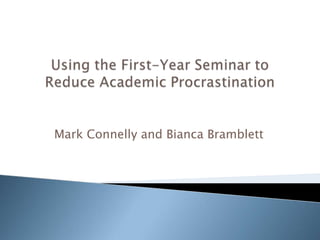
Team Time Sigma Xi Presentation
- 1. Mark Connelly and Bianca Bramblett
- 2. 70% of college students procrastinate (Ferrari, 1995). Leads to missing deadlines for submitting assignments, claiming test anxiety, obtaining low course and semester grades, and low cumulative GPA (Beswick, Rothblum, & Mann, 1988; Rothblum, Solomon, & Murakami, 1986; Watson, 2001).
- 3. Students who procrastinate report more ◦ colds and flu ◦ gastrointestinal problems ◦ insomnia (Ferrari, 2004).
- 4. There are three different time perspectives ◦ Past (positive and negative) ◦ Present (hedonistic or “pleasure-seeking” and fatalistic or “fate based”) ◦ Future (Zimbardo & Boyd, 1999.)
- 5. The Big Five Mini-Marker is a shortened version of the Big Five Aspect Scale. ◦ Conscientiousness is the strongest predictor of procrastination (Schouwenberg & Lay,1995).
- 6. 1. Will an intervention reduce the amount of procrastination displayed by college students? 2. Will students with different time perspectives react differently to the intervention? 3. How do personality factors influence procrastination?
- 7. 1. Can GPA be a predictor of procrastination? 2. Will the students turn essays in faster after the intervention than they did before it? 3. Will students become more aware of their cognitive processes?
- 8. Consisted of 46 students from the first year psychology seminar class. (30 Females and 16 Males)
- 9. Stanford Time Perspective Inventory-short form (STPI) Big Five Mini-Markers Scale The Aitken Procrastination Inventory Metacognitive Awareness Inventory A brief demographic survey
- 10. Aitken Procrastination Inventory Example: “I often wait until the last minute to get things done.” Rated on a 1-5 Likert Scale STPI Example “It upsets me when people are late for appointments.” Rated on a 1-5 Likert Scale Metacognitive Awareness Inventory Example: “I ask myself periodically if I am meeting my goals.” Answered either true of false
- 11. The participants completed a survey in class consisting of the measures for both the pre and posttests after giving informed consent. It was used to assess whether the students turned assignments in faster after the intervention.
- 12. Created the syllabus along with Dr. Blasko ◦ Utilized methods of preventing procrastination (e.g. chunking, time management skills) Taught a lesson to the class utilizing pretest results to show how they ranked. ◦ Offered areas of improvement.
- 13. t(36) = 3.5, p = .001
- 14. Time Perspective Correlations N=46 Past Past Present Present Future Negative Positive Fatalism Hedonism Procrastination -.057 .180 .350* .412* -.722** Note. **Indicates that correlation is significant at the 0.01 level * Indicates significant at the .05 level
- 15. School Factors Correlations N=46 Essay Turn in High School Predicted GPA Time GPA Procrastination -.438* -.180 -.097 Note. **Indicates that correlation is significant at the 0.01 level * Indicates significant at the .05 level
- 16. 5 4 Mean Score 3 2 1 Pretest 0 Posttest Future: t(36) = 3.13, p = .003 Present Fatalistic: t(36) = -4.01, p = .000
- 17. 1. Will an intervention reduce the amount of procrastination displayed by college students? Yes 2. Will students with different time perspectives react differently to the intervention? Yes 3. How do personality factors influence procrastination? No Supporting Data
- 18. Can GPA be a predictor of procrastination? No Supporting Data Will the students turn essays in faster after the intervention than they did before it? Yes Will students become more aware of their cognitive processes? Yes (M= 35.38) to (M= 38.97).
- 19. We did not have a comparison group. Factors could influence procrastination that were not measured. The study is being conducted on a very select group of students.
- 20. Possible new tools and methods for reducing procrastination in an academic setting. Can help to reduce student anxiety and also has the potential to help the students achieve higher grades and learn more.
- 21. Beswick, G., Rothblum, E. D. and Mann, L. (1988), Psychological antecedents of student procrastination. Australian Psychologist, 23, 207–217. Ferrari, J. R., Johnson, J., & McCown, W. G. (1995). Procrastination and task avoidance: Theory, research, and treatment. New York: Plenum Press. Rothblum, E., D.; Solomon, L., J.; Murakami, J. (1986). Affective, cognitive, and behavioral differences between high and low procrastinators. Journal of Counseling Psychology, 33(4), 387-394. Schouwenberg, H.C., & Lay, C. L. (1995). Trait procrastination and the big five factors of personality. Personality and Individual Differences, 18, 481-490. Watson, D.C. (2001). Procrastination and the five-factor model: A facet level analysis. Personality and Individual Differences, 30, 149-158. Zimbardo, P. G. & Boyd, J. N. (1999). Putting Time in Perspective: A Valid, Reliable Individual-Differences Metric. Journal of Personality & Social Psychology, 77(6), 1271-1288.
- 22. The authors would like to thank Dr. Dawn Blasko, our faculty advisor, for her guidance and support throughout the research process, along with Dr. Robert W. Light, Senior Associate Dean, for his financial support through the grant program at Penn State Behrend.